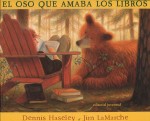un mundo iluminado
El oso que amaba los libros
año: 2002, isbn: 84-261-3395-9, signatura: 161
autor/es
ilustrador/es
editorial/es
Así comienza
Un día, un joven oso que estaba humeando entre los setos, descubrió un trozo de papel. Lo observó con mucha atención. Olfateó sus diminutos signos y después lo agarró entre los dientes y se lo llevó a su cueva.
Los años iban pasando y el oso seguía fascinado con aquel papel.
En un paseo por el bosque, un oso encuentra un trozo de papel escrito. Aunque no puede leerlo, causa en él tal magnetismo y curiosidad, que le empujará a ir a escuchar las historias que una joven lee todos los días sentada junto a su cabaña.
Un álbum sobre la magia de leer… y de escuchar historias.
Interview with Jim LaMarche—Illustrator of A Story for Bear
Q: What’s your childhood bear story, Jim?
A: Spending my summers in northern Wisconsin, I have a number of bear stories. I remember my grandma singing and banging on pots to make sure the bears knew we were coming to pick raspberries and wild blueberries. I remember my dad piling my brothers and sisters into the Rambler station wagon for a trip to the dump. Dad would park and shut off the engine and lights, smoke his pipe, and we would wait for the sound of the bears. We were seldom disappointed. I think I was always a little embarrassed for the bears, caught in such a humiliating situation
Q: The eyes of Bear are not detailed—essentially they are two black dots—and yet each picture clearly shows expression: curiosity, attentiveness, happiness. How did you manage to create so much character without using eye detail?
A: How does a teddy bear with button eyes manage to convey a gentle soul? How does my big black poodle with the blackest of black eyes show such an array of emotion? He’s sitting at my feet right now; I can barely see his eyes and yet I can easily read peaceful contentment in his face. I think when we see the eyes, we are really seeing the whole. I can accidentally change an emotion in a face when transferring a rough drawing to the final art. Sometimes I can’t quite tell how I captured the emotion-how it happened. And sometimes the rough can be true to form and the final not quite where it should be. I felt Dennis Haseley’s sweet and beautiful story was essentially about a parent reading to a child. It doesn’t matter that the child is a 250 pound bear; the bear’s expressions and body language had to be dependably safe, and had to reflect this human-bear relationship as an oasis in a big woods. A shorter answer might be that I use intuition, trial and error, to achieve the emotion in my characters.
Q: The colors you use for A Story for Bear are rich, vibrant, and warm. How did you choose these for the illustrations? Did you consciously choose the colors to match the season, autumn, during which time the story takes place?
A: While working on this book I went on a family backpacking trip in the Sierras. The light in the mountains is clean, clear, and blue. Very little atmosphere. It feels open, forever, like standing on the edge of the universe. I wanted the trees and mountains of the Sierras for this story, but I needed the close intimacy of a warm and hazy light-a Southern light. I could hear the woman reading in a soft Southern accent. I wasn’t as concerned with using autumn colors as I was with using comforting color.
Q: The original pictures for the book were done in acrylic and colored pencil. What is your process for mixing these mediums to create such beautiful and softly textured illustrations?
A: I lay down some washes-large blocks of color-on Arches 300 lb. watercolor paper. When the paper is bone dry, I use the colored pencils on top for detail. The pencil adds a rich texture but not intense color. I’m attracted to muted natural colors with just small jewels of richer color.
Q: How does it feel not working directly with the author?
A: It must be difficult for an author to let go of a story and put it into the hands of someone else. I’m sure Dennis had a face in mind for the woman in this story. Perhaps his own mother, or maybe a former school teacher. He also «saw» a place, a time, the cottage , the type of woods and of course the bear. That’s the illustrator’s dilemma—trying to understand the heart and soul of a story without getting bogged down in the author’s personal images. It’ wonderful to have an editor who understands this and gives the illustrator room to work. Our editor is like a matchmaker, she knows which authors and illustrators work together. In the long process she is the objective third eye, knowing what works and what doesn’t, what stays in or goes out. I spend many months on creating illustrations for books and feel very fortunate to have worked on Dennis’s beautiful story.
Palabras clave
Tecnicolor.es
Este es un sitio sin propósito comercial que tampoco incluye publicidad. Su única finalidad es la difusión cultural. Los derechos de autor de las ilustraciones mostradas y de las citas literarias pertenecen a sus autores y en su caso, a los editores, que son siempre citados a pie de ambas.
© Fernanda Medina. …quieres hablar conmigo?


